|

 Up
Up 
 Military Flyer
Military Flyer 
(You are here.)



  Need
to Need
to
find your
bearings?
Try
these
navigation aids:
If
this is your first
visit, please stop by:
Something
to share?
Please:



|
|
Available in Française, Español, Português, Deutsch, Россию,
中文,
日本, and others.
 he
U.S. Army purchased its first aircraft from the Wright brothers in August
1909 after the brothers demonstrated an airplane that fulfilled all
the the conditions that had been set out in "Signal Corps
Specification 486," for a "heavier-than-air flying machine" issued
23 December 1907. The Wrights first brought a
Wright Model A airplane to Fort Myer, Virginia for testing on 20
August 1908. After a series of successful flights, the airplane
crashed on 17 September 1908, severely injuring Orville and killing
his passenger, Lt. Thomas Selfridge. Despite the tragedy, the Army
was convinced the Wrights had built a capable airplane and extended
their contract for one year. he
U.S. Army purchased its first aircraft from the Wright brothers in August
1909 after the brothers demonstrated an airplane that fulfilled all
the the conditions that had been set out in "Signal Corps
Specification 486," for a "heavier-than-air flying machine" issued
23 December 1907. The Wrights first brought a
Wright Model A airplane to Fort Myer, Virginia for testing on 20
August 1908. After a series of successful flights, the airplane
crashed on 17 September 1908, severely injuring Orville and killing
his passenger, Lt. Thomas Selfridge. Despite the tragedy, the Army
was convinced the Wrights had built a capable airplane and extended
their contract for one year.
With the assistance of their
employees Charley Taylor and Charley Furnas, the Wrights built
another aircraft, the Wright Military Flyer, and shipped it to Fort
Myer on 18 June 1909. The Military Flyer differed from the Model A
in that it had a slightly shorter wingspan, longer propellers, set
higher off the ground, and had a different gear ratio in the power
transmission. These changes were made to increase the speed of the
aircraft, since the purchase price depended partly on air speed. The
motor was the same as had been used the year before, but produced
slightly more horsepower because it had been "broken in."
Wright Military Flyer specifications:
- 36.5 ft (11.1 m) wingspan
- 5.8 ft (177 cm) chord
- 5 ft (152 cm) separation
- 415 sq ft (38.6 sq. m) wing area
- 1:20 camber
- 80
sq ft (7.4 sq m) double horizontal front rudder
- 16 sq ft (1.5 sq m) twin movable vertical rear rudders
- 28.9 ft (8.8 m) overall length
- 735 lb (333.4 kg) total weight (without pilot)
- 4 cylinder engine, 32 hp at 1310 rpm
- Two contra-rotating propellers, 9 ft (274 cm) long, turning
at 425 rpm
- 42 mph (67.6 kph) average speed
Test flights began on 29 June 1909. Both Wilbur and Orville were
present, although Orville did all the flying. On 30 July 1909,
Orville flew the last test -- the speed test -- with Lt. Benjamin D. Foulois as his passenger. The aircraft averaged a speed of 42.58
miles per hour over a flight distance of 44 miles. With these
results, the Army agreed to pay the Wright brothers $25,000 for the
Wright Military Flyer with a bonus of $5000 ($2500 for each mile per
hour over 40 mph).
The aircraft was transferred to Army facilities at College Park,
Maryland where Wilbur flew it to
train the first U.S. Army pilots, Lt. Frank P. Lahm and Lt. Frederic E. Humphries
during October
1909. During this training, Wilbur experimented with a horizontal surface
in the rear of the aircraft to increase pitch stability, as Orville was
doing in Germany. These experiments would eventually lead to the
Wright Model B.
In 1910, Lt. Benjamin Foulois took it to Fort Sam Houston, San Antonio,
TX, and learned to fly it by corresponding with Orville Wright. In the
summer of 1910, Foulois' mechanic installed the first wheels on a Wright airplane.
About the same time, the Wrights began to install wheeled landing gear on
all their airplanes. The Wrights restored the Military Flyer to its
original wheel-less configuration in May 1911 for
permanent display at the Smithsonian on 20 October 1911.
References:
- McFarland, Marvin W. (ed), "The papers of Wilbur and Orville
Wright." McGraw-Hill Book Co., New York, 1953, p 1195-1196,
plates 183-191.
- Chandler, Charles deForest and Lahm, Frank P., "How our Army
Grew Wings." Ronald Press Co., New York, 1943, p 183
[Submitted by Joe W. McDaniel] |
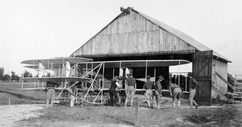
Soldiers at Fort Myer pull the 1909 Wright Military Flyer out of its
temporary hangar.
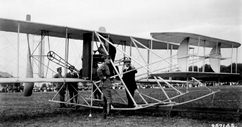
Charlie Taylor pours fuel into the gas tank of the Flyer while Orville
goes over the proposed flight route with his passenger, Lt. Frank Lahm.
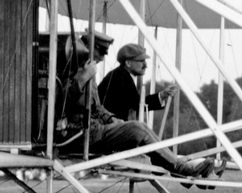
Orville and Lt. Lahm seconds before take-off. Orville is reaching
down between the seats to trip a small catch that will release the
Flyer and start the catapult weight fallling.
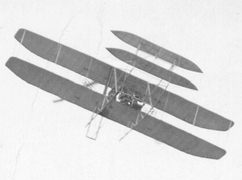
The Military Flyer passes overhead.
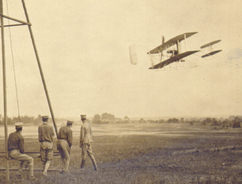
Soldiers watch the Military Flyer as it completes the speed trial
and descends to land.
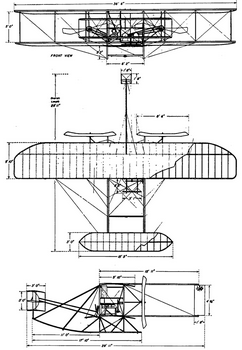
Front, top, and side drawings of the Wright Military Flyer.
|
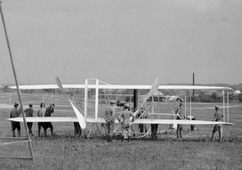
The soldiers place the Military Flyer on the launching rail.
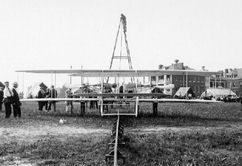
With the Flyer in place on the rail, a soldier prepares to "cock"
the catapult (raise the weight).
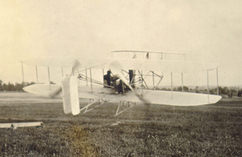
The Military Flyer reaches the end of the launch rail and begins to
climb.
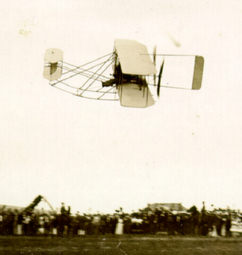
The Military Flyer banking left over the crowds at Fort Myer.
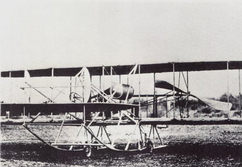
The Military Flyer was moved to Fort Sam Houston near San Antonio, Texas
on February 15, 1910. In August,
Oliver G.
Simmons – the first U.S.
military flight mechanic – installed wheels on the aircraft so the
crew could launch it without using the catapult.
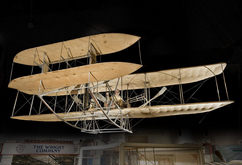
The 1909 Wright Military restored to its original configuration at
the Smithsonian Air & Space Museum.
|